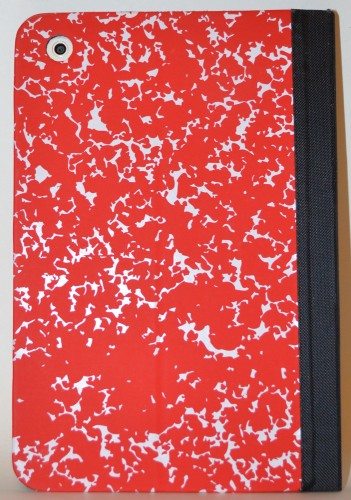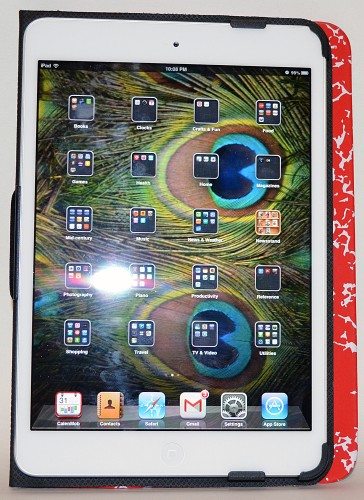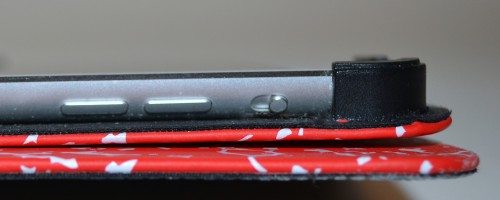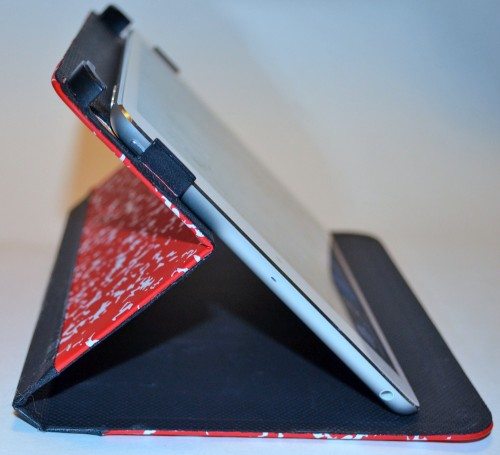As I’ve said before, I do like a quirky case for my electronics. The IH-IM1106 Composition Book Case for iPad mini from iHome certainly meets the quirky criteria. It’s about the same size and certainly has the same appearance as those composition notebooks so familiar to school children. You could even fill in the label with a subject and your name to add to the illusion, if you wanted. Its weight with the iPad mini in place is close to that of a regular composition book, too. It’s so convincing that when I handed it to my husband to check out, he gave me a confused “okay, it’s a composition book – so what?” look. I love the look of my latest Amazon purchase, but how does it work?
Click any image for an enlarged view.
I’ve had a lot of accessories from iHome, but they were speakers, keyboards, and alarm clocks. I wasn’t even sure they had cases until I was looking at Amazon one day. I saw one of these cases for the full-sized iPad, but I had moved on to the iPad mini by then. When I finally saw Amazon had the mini-sized case, I immediately ordered it.
The cases for the iPad mini (and for the full-sized iPad, too) are available with black, red, green, or blue speckles. I, being me, ordered the red cover. The cases are hard, even thicker and harder than the covers of actual composition books. The better to protect your screen, my dear!
The exterior of the case is made of a white vinyl, and the colored speckles are some sort of rubbery material that improves the grip that’s been applied over the vinyl. The spine of the notebook is covered with some sort of heavy, cloth “tape”. The front “label” isn’t a separate piece; it’s simply some of the white material that hasn’t been covered with the speckles. I was really tempted to write my name on this label with a Sharpie, but I decided to skip that in case I decide to pass this case along to someone else later on.
The case measures about 8.15″ long X 5.5″ wide X 0.6″ thick. It weighs 4.25 ounces.
 The back has an opening for the iPad mini’s back camera, as you’d expect. It’s hard to see in this picture, but the back also has a groove or “bend” in it that allows the case to be used as a horizontal stand.
The back has an opening for the iPad mini’s back camera, as you’d expect. It’s hard to see in this picture, but the back also has a groove or “bend” in it that allows the case to be used as a horizontal stand.

The interior is lined with a “pebbled” rubbery material. On the left of the above image, you can see “dents” in the top and bottom corners. These are where the hard, plastic clips that hold the iPad mini in place will rest when the cover is closed. These clips don’t have a lot of “give”, so you’ll have to bend the back of the case at the “groove” and slide the edge of the mini under them. At the spine, you’ll see another long clip. This one does have a bit more give, and you snap it over the edge of the iPad mini to hold it securely in the case. And the iPad mini is held securely. I never once felt the iPad was in danger of falling out of the case while I had that side piece clipped in place.
You can see that not much of the edges of the iPad mini is covered by these clips. This means the screen is easy to clean, because you can just wipe dust over the side of the mini without trouble.
 Here’s the mini in place. The front of the case has hidden magnets that operate the iPad mini’s sleep/wake function. This feature worked well with my mini. The magnets aren’t strong enough to hold the cover closed, though. I think this may be partially due to the thickness of the top of those plastic clips, which holds the front of the cover just slightly above the surface of the iPad.
Here’s the mini in place. The front of the case has hidden magnets that operate the iPad mini’s sleep/wake function. This feature worked well with my mini. The magnets aren’t strong enough to hold the cover closed, though. I think this may be partially due to the thickness of the top of those plastic clips, which holds the front of the cover just slightly above the surface of the iPad.
Because the clips cover so little of the iPad, they don’t interfere at all with using the touchscreen.
 The spine is flexible enough that you can fold the front cover completely to the back. However, the spine doesn’t fold in the center, so the edge of the front cover doesn’t line up with the edge of the back. This extra width does interfere with holding the iPad one-handed. I can’t “palm” the iPad mini with the cover folded back like this. I can still hold it one-handed; I just grip it in my left hand in a “pincher” grip.
The spine is flexible enough that you can fold the front cover completely to the back. However, the spine doesn’t fold in the center, so the edge of the front cover doesn’t line up with the edge of the back. This extra width does interfere with holding the iPad one-handed. I can’t “palm” the iPad mini with the cover folded back like this. I can still hold it one-handed; I just grip it in my left hand in a “pincher” grip.
 If you do line the front and back covers up when the front is folded back, you get a wedge-shaped spine. This also can interfere with a one-handed grip. It doesn’t add enough lift to really make the case useful as a typing stand. How the case folds back isn’t that big a problem to me. It certainly isn’t a deal breaker for me.
If you do line the front and back covers up when the front is folded back, you get a wedge-shaped spine. This also can interfere with a one-handed grip. It doesn’t add enough lift to really make the case useful as a typing stand. How the case folds back isn’t that big a problem to me. It certainly isn’t a deal breaker for me.
You can see that the Lightning connector is accessible with the iPad mini in the iHome case. Most of the bottom speakers are left uncovered, too. I didn’t notice a loss of sound when the mini is in this case.
 The edges of the back extend past the edges of the iPad mini. On one hand, this is a plus, because the stiff edges of the case will take the brunt of a drop or a hit instead of the iPad. However, this stiff extension combined with the slim, very sloped profile of the iPad mini means it’s hard to get your fingers in to operate the screen lock/mute button or the volume buttons.
The edges of the back extend past the edges of the iPad mini. On one hand, this is a plus, because the stiff edges of the case will take the brunt of a drop or a hit instead of the iPad. However, this stiff extension combined with the slim, very sloped profile of the iPad mini means it’s hard to get your fingers in to operate the screen lock/mute button or the volume buttons.
 You can see that most of the top edge is also left uncovered, so the microphone, headphone jack, and power button are exposed. Again, the sloped profile means the power button is tough to reach. Luckily, I don’t use that button very often because I rely on the sleep/wake function.
You can see that most of the top edge is also left uncovered, so the microphone, headphone jack, and power button are exposed. Again, the sloped profile means the power button is tough to reach. Luckily, I don’t use that button very often because I rely on the sleep/wake function.
 I never use my iPad cases as stands, except when I shoot photos for reviews. I had no problems with the case and saw no flaws in its design until it was time to take a photo of the stand feature. When I popped the inner clip off the side of the mini so I could set the case up as a stand, I discovered a very important problem. The plastic guides on the outer edges of the iPad do not grip the iPad at all. When I popped the side piece loose, my iPad mini almost slid right out of the case onto the floor.
I never use my iPad cases as stands, except when I shoot photos for reviews. I had no problems with the case and saw no flaws in its design until it was time to take a photo of the stand feature. When I popped the inner clip off the side of the mini so I could set the case up as a stand, I discovered a very important problem. The plastic guides on the outer edges of the iPad do not grip the iPad at all. When I popped the side piece loose, my iPad mini almost slid right out of the case onto the floor.
The front of the case has no grooves or “stops” to hold the iPad at preset viewing angles. I guess iHome assumed the grippy texture of the interior was enough to hold the mini in place. No grooves means that you have more viewing angles to choose from, too. However, you can see that the iPad is sliding out of the corner clips. Only the friction of the grippy front cover against the edge of the iPad mini is holding it in place. If you bump the case, you could cause the iPad to slip and slide right out of the case. Also, some folio cases with this basic design can be folded flatter than I show here so the case can be used as a typing stand for the on-screen keyboard. You won’t be able to use this case as a typing stand, though. If you fold it much flatter than I’ve shown here, the iPad will just slide completely out of the case.
If I ever used a case as a stand, the loose hold on the iPad mini would be the deal breaker. I don’t use a stand, so I still think it is a good, fun case. If you also will never use the iHome IH-IM1106 Composition Book Case for iPad mini as a stand, I think you’ll find it a good case with only a couple of flaws – namely, the buttons are hard to reach and the way the front folds back makes some one-handed holds difficult. If you do constantly use the stand feature, I think you should forget the iHome Composition Book for your iPad mini.
Apple iPhone FineWoven Wallet with MagSafe – Black
15% OffESR for MagSafe Wallet with Stand, RFID Blocking with MagSafe Ring, 5 Card Holder for Phone Case, Slim Leather Magnetic Wallet for iPhone 17/16/15/14/13/12 Series(Not for Mini), Selected Samsung,Black
33% OffProduct Information
| Price: | $34.99 |
| Manufacturer: | iHome |
| Retailer: | Amazon |
| Requirements: |
|
| Pros: |
|
| Cons: |
|



